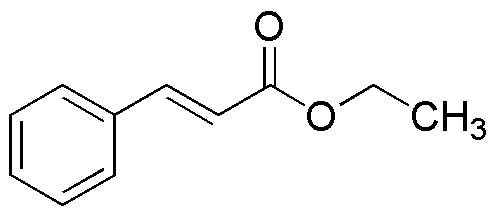Ethyl cinnamate is widely utilized in research focused on:
- Flavoring and Fragrance Industry: This compound is commonly used as a flavoring agent in food products and as a fragrance in perfumes and cosmetics due to its pleasant, sweet, and fruity aroma.
- Pharmaceutical Applications: Ethyl cinnamate has shown potential in drug formulation, particularly in enhancing the solubility and bioavailability of certain medications, making it valuable in pharmaceutical development.
- Natural Product Synthesis: It serves as a key intermediate in the synthesis of various natural products and bioactive compounds, aiding researchers in developing new therapeutic agents.
- Cosmetic Formulations: The compound is used in skincare products for its antioxidant properties, which can help protect the skin from damage caused by free radicals.
- Agricultural Applications: Ethyl cinnamate has been explored for its potential as a natural pesticide and insect repellent, offering an eco-friendly alternative to synthetic chemicals in pest management.
Informations générales
Propriétés
Sécurité et réglementation
Applications
Ethyl cinnamate is widely utilized in research focused on:
- Flavoring and Fragrance Industry: This compound is commonly used as a flavoring agent in food products and as a fragrance in perfumes and cosmetics due to its pleasant, sweet, and fruity aroma.
- Pharmaceutical Applications: Ethyl cinnamate has shown potential in drug formulation, particularly in enhancing the solubility and bioavailability of certain medications, making it valuable in pharmaceutical development.
- Natural Product Synthesis: It serves as a key intermediate in the synthesis of various natural products and bioactive compounds, aiding researchers in developing new therapeutic agents.
- Cosmetic Formulations: The compound is used in skincare products for its antioxidant properties, which can help protect the skin from damage caused by free radicals.
- Agricultural Applications: Ethyl cinnamate has been explored for its potential as a natural pesticide and insect repellent, offering an eco-friendly alternative to synthetic chemicals in pest management.
Documents
Fiches de données de sécurité (FDS)
La FDS fournit des informations de sécurité complètes sur la manipulation, le stockage et l’élimination du produit.
Spécifications du produit (PS)
Le PS fournit une description complète des propriétés du produit, notamment sa composition chimique, son état physique, sa pureté et les exigences de stockage. Il détaille également les plages de qualité acceptables et les applications prévues du produit.
Certificats d'analyse (COA)
Recherchez des certificats d'analyse (COA) en saisissant le numéro de lot du produit. Les numéros de lot et de lot se trouvent sur l'étiquette d'un produit, après les mots « Lot » ou « Lot de fabrication ».
Numéro de catalogue
Numéro de lot/série
Certificats d'origine (COO)
Ce certificat d'exploitation confirme le pays dans lequel le produit a été fabriqué, et détaille également les matériaux et composants utilisés et s'il est issu de sources naturelles, synthétiques ou autres sources spécifiques. Ce certificat peut être requis pour les douanes, le commerce et la conformité réglementaire.
Numéro de catalogue
Numéro de lot/série
Fiches de données de sécurité (FDS)
La FDS fournit des informations de sécurité complètes sur la manipulation, le stockage et l’élimination du produit.
DownloadSpécifications du produit (PS)
Le PS fournit une description complète des propriétés du produit, notamment sa composition chimique, son état physique, sa pureté et les exigences de stockage. Il détaille également les plages de qualité acceptables et les applications prévues du produit.
DownloadCertificats d'analyse (COA)
Recherchez des certificats d'analyse (COA) en saisissant le numéro de lot du produit. Les numéros de lot et de lot se trouvent sur l'étiquette d'un produit, après les mots « Lot » ou « Lot de fabrication ».
Numéro de catalogue
Numéro de lot/série
Certificats d'origine (COO)
Ce certificat d'exploitation confirme le pays dans lequel le produit a été fabriqué, et détaille également les matériaux et composants utilisés et s'il est issu de sources naturelles, synthétiques ou autres sources spécifiques. Ce certificat peut être requis pour les douanes, le commerce et la conformité réglementaire.

